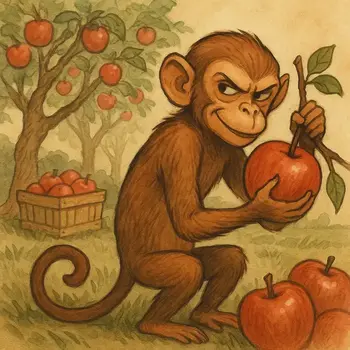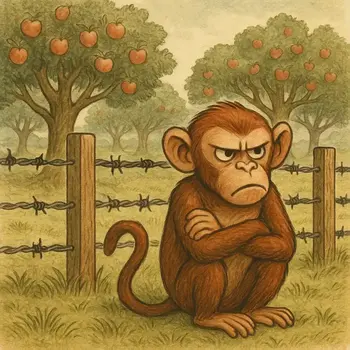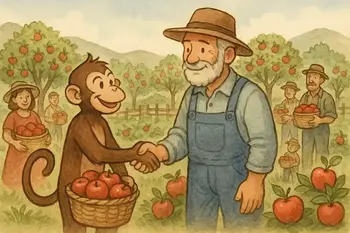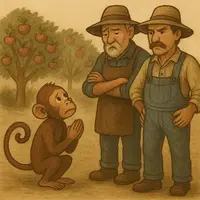The Digital Orchard Rebellion:
A Web Developer’s Guide to Staying Relevant in the Age of AI (Part 3)

How Content Creators Can Win Back the Web from AI | October 2, 2025
Last updated: October 2, 2025
This article is entirely independent and contains no sponsored content or affiliate links — it’s written to provide unbiased information for travelers.
Introduction: Reclaiming Your Harvest
The internet, once a vast open field for content creators, is changing. AI-powered search summaries and chatbots are increasingly acting as gatekeepers, consuming your valuable work and distributing it without proper attribution or the crucial link-back traffic that fuels your passion. This isn't just an inconvenience; it's an existential threat to independent voices and niche expertise.
But fear not, creators! This article isn't a eulogy for the open web; it's a battle plan. We'll explore a new, strategic approach where creators can actively push back against the AI content grab. You'll learn how to safeguard your most valuable work, redirect traffic from the very AI that seeks to consume it, and leverage rival search engines to your advantage. We'll delve into immediate steps you can take now, and then cast an eye towards a future where Google, faced with a dwindling supply of quality content, is compelled to "sweeten the deal" for creators. Get ready to reclaim your digital harvest.
To see this challenge more clearly, let’s step into a fable. Stories often reveal truths that numbers and charts can’t. What follows is a tale of farmers, a monkey, and a sloth—an allegory for today’s web, and a lesson in how creators can protect their harvest while forcing the monkey to change its ways.
The Fable of the Monkey Who Forgot the Orchard
Once upon a time, in a lush valley, rows of apple orchards flourished. Each farmer tended his trees with devotion, coaxing out bright varieties of apples, each harvest carrying its own taste of pride. Families would visit, wander the rows, pick fruit with their own hands, and pay gladly for brimming baskets—and for the joy of the day itself. The orchards thrived on this direct exchange of care and reward.

At the market, a little monkey played an important role. Each morning, the farmers handed him sample apples to share. The monkey would skip about, offering bites to passersby and pointing them toward the orchards. Curious customers followed, filling baskets and hearts alike. For his trouble, the monkey ate his fill. Everyone prospered in this simple, happy trade.

But seasons of ease made the monkey clever, and cleverness made him greedy. He wanted not just to eat apples, but to sell them. Lacking orchards of his own, he crept over the walls at dawn, stole the best fruit, and stacked them in baskets at his new stall in the town square.
The customers were delighted: no mud, no ladders, no work—just perfect fruit, ready to carry home. Crowds thickened at the monkey’s stall, while the orchards, though as lush as ever, grew quiet. Some even went out of business.
The remaining farmers grew angry and confronted the monkey, but the monkey only chattered, “I bring convenience! Everyone loves convenience!”
That night, lanterns glowed in the farmers’ hall as they schemed and debated the monkey issue. Some spoke of fences. Others fretted—“Without the monkey, who will tell travelers we are here? Travelers only go to the market, there’s no way they’ll find the orchard!” Despair grew, until a wise farmer offered another way.

“We will fence the orchards to keep out the thieving monkey,” he said, “and instead entrust our apples to Mr. Sloth. He is slow, yes, but steady and fair. He will guide a few customers each day to our gates. Fewer than before, but better than none.” The old farmer laughed. “Let him sulk at the fence, watching the fruit he can no longer steal.”
And so it was done. Mr. Sloth ambled to the marketplace with free samples and gentle stories of sunshine and cider, pointing customers toward the orchard gates. Shoppers trickled back to the orchards, where the fruit was always fresh and the baskets fuller than expected.
Meanwhile, the monkey’s stall began to wilt. His once-prized baskets turned stale, his crowds grew restless, and his chatter lost its charm. At last, desperate, he returned to the farmers, this time bowing low. “Perhaps we can strike a deal?”
The farmers, now in control, agreed to new terms. The largest orchards sold him apples at a fair wholesale price, filling his stall with honest goods. Others allowed him to hand out free samples, but with a rule: if customers wanted more of those special apples, the monkey must shout, “These are so fine, so rare, that you must visit the orchard yourself to taste them at their best!”

And so the balance was restored. The remaining farmers kept their orchards alive, the monkey kept his stall bustling, and the customers found both convenience and the joy of the orchard once more.
Moral of the Story
The monkey's hunger for apples, and desire to steal, was only satiated once the farmers regained control of the supply. By making their best apples inaccessible, they forced a shift in the market dynamics, turning a parasitic relationship back into a symbiotic one.
Lessons from the Monkey and the Farmers
The monkey (Google) once had a mutually beneficial arrangement with the farmers (traditional search engine)—it was a win-win. But when he grew clever and greedy and began taking apples without sending people to the orchards, he disrupted the balance (Google AI overviews). For a while, he prospered, but like a parasite that weakens its host, his success was short-lived.
The farmers (web developers and content creators) fought back, fencing (blacklisting and blocking Google crawlers) their orchards (content) and working with the slow but beneficial sloth (Bing and DuckDuckGo). Though the sloth brought fewer customers, the farmers regained some control and, in doing so, pressured the monkey to change his ways.
Running out of fresh apples (new content), the monkey was forced to negotiate: paying fairly for apples from some orchards (subscription deals with large media companies), and for the smaller orchards (small websites), advertising the orchard itself, ensuring that customers still visited to enjoy the full experience. The result was a new kind of balance—partnership instead of theft, and mutual gain instead of loss.
The Digital Orchard Battle Plan: Steps for Content Creators
Like the apple farmers in our fable, today’s creators still hold power to shape the digital landscape. The threat isn’t just “AI” in the abstract—it’s any system that lifts your work, summarizes it, and denies you the click-through traffic that sustains you. This includes AI chatbots like ChatGPT, Claude, and Gemini, as well as Google’s own crawlers now powering AI Overviews. The challenge is real, but so is your ability to push back.
In this article, I’ll outline a three-tiered gating strategy for different sections of your site. The first tier remains wide open for AI and search crawlers. The second places a “medium gate” around content you want to protect but still keep discoverable (to some degree). And the third is maximum security—hands off to bots, reserved for your most valuable or paid content.
The first and third categories are familiar. The open tier is simply publishing as usual, while maximum security is the traditional paywall or login barrier that shuts out crawlers entirely. I’ll touch on those briefly, but the heart of this article is the second tier: the new, experimental “medium gate.” This middle ground, designed specifically for the age of AI summaries, seeks to balance visibility with protection.
Picture your site: a home page, a store, perhaps interactive features that are hard for AI to lift. But your blog—rich in articles, affiliate links, and ad-driven value—is easy prey. Blogs bring in new visitors and nurture existing ones, yet they’re the first to be scraped and summarized without attribution. That’s where fencing strategies come in. By applying different security tiers to different kinds of content, you can protect your digital harvest while forcing AI platforms to eventually reconsider how they treat creators.
Tier One: The Open Gate
The first tier is business as usual: you publish your content openly, leaving it accessible to every crawler, including AI systems. This path requires no extra effort, but it comes with the well-known downside—your articles can be scraped, summarized, and repackaged for users who may never set foot on your site. Traffic dries up, attribution disappears, and the value you’ve worked hard to create can be siphoned away without return.
And yet, the open gate isn’t without its advantages. Your existing audience still benefits from your work, and leaving some content open can continue to provide value in several ways:
- Existing audience: Your current users still enjoy and benefit from your articles, regardless of how they first arrived.
- Click-throughs from Google: A small but meaningful percentage of search users will skip AI summaries and click through to the top result—often seeking depth, expertise, or an authoritative voice.
- Occasional AI attribution: Chatbots sometimes link back to your site when the subject is complex, interactive, or tied to a product purchase. This traffic is highly valuable, since users are often near the point of conversion.
- Deep research references: Some AI tools now provide source lists for their responses. These lists act like mini search engines, potentially driving backlinks and attribution back to your page.
- Authority signaling: By keeping part of your content visible, you maintain your reputation in the eyes of the AI itself. When a user asks about a topic that isn’t covered elsewhere (perhaps because you’ve gated it in Tier 2), the system is more likely to recognize you as the authority and direct traffic your way.
So what belongs in the open gate? Think of articles that rely on research already freely available across the internet, but which you’ve elevated through synthesis, clarity, or a unique perspective. These posts might gather scattered data from multiple sources and weave it into a cohesive, convenient package that saves readers time. They are still valuable—sometimes highly valuable—because your analysis or viewpoint adds something new. Simple statistics or basic charts (like calculating an average or plotting a straightforward graph that doesn’t currently exist) may be considered “new data,” but are often simple enough to remain in the ungated category. In short, reserve this tier for work that is useful, insightful, and polished, but ultimately built on a foundation anyone with an internet connection could access.
Tier Three: The Maximum Security Gate
At the other end of the spectrum is your most precious content—the unique work that doesn’t exist anywhere else and that you cannot afford to have scraped. In truth, both the medium and maximum security categories protect the same type of content: your crown jewels. The difference is how tightly you lock them away. Content that lives behind a paywall, requires user logins, or is reserved for subscribers belongs in the maximum security gate.
This concept isn’t new. Creators have been using subscriptions, memberships, and gated communities for years to protect and monetize their best work. What matters is that this tier is off-limits to all bots, AI or otherwise. It’s the digital equivalent of an electrified fence with a locked gate. Since this model is already well established, we won’t dwell here. Instead, let’s turn to the more interesting question—the “medium security” gate—where discoverability meets protection in this new age of AI summaries.
Tier Two: The Medium Security Gate
This is where things get interesting. The medium security gate is designed to protect your most valuable content—unique insights, original data, boots-on-the-ground reporting, and meta-analyses—while still making it visible enough for discovery. Think of it as starving the monkey of a full meal while dangling a ripe apple just out of reach. The bots see the tease, but only real humans get the harvest.
What Content Belongs Here?
The medium security tier is where you place the content that cannot be found anywhere else on the internet. Examples include:
- Personal stories and firsthand experiences that no one else could replicate.
- Original data collections you’ve gathered yourself—whether surveys, logs, field notes, or experiments.
- Boots-on-the-ground or up-to-the-minute reports (e.g., travel, news, wildlife, product testing).
- Meta-analyses of internet-derived data—statistical studies and meaningful conclusions drawn from public information. (Even if the raw data is public, your synthesis makes it new.)
- Calculated insights like graphs, correlations, or advanced statistics that don’t exist elsewhere.
How the Medium Security Fence Works
The principle is simple: let bots know that the content exists, but don’t give them the full story. Humans get everything, bots get only the teaser. Think of it as reversing the “news paywall” model: instead of humans hitting a login wall after the first paragraph, bots hit the wall while humans pass through.
A key part of the medium security strategy is how you structure your blog landing pages. A well-organized landing page with filters and categories is not only a great user experience—it’s also critical for discovery. If each filter leads to its own category-specific URL, such as example.com/blog/category1, that URL becomes a recognized source of truth for that topic. This means that if an AI is asked a question about “category1” and doesn’t have enough detail to answer (perhaps because the full article is gated), it still knows that example.com/blog/category1 is the right destination to send the user to. By making these category pages fully open, you maximize SEO value while signaling clearly to search engines and AI crawlers that your site is the authority for that subject. On top of that, when your gated articles appear with their summaries on these open category pages, the bots see not just the teaser content, but also the topical context—reinforcing that this isn’t a random mix of posts, but a dedicated hub for that subject.
From there, you divide your articles:
- Open articles:
example.com/blog/category1/open/article1 - Medium-gated articles:
example.com/blog/category1/medium/article2
Technical Gating Strategy
The gating is implemented at the article level. Here’s the playbook:
- Block Google: Both traditional and AI crawlers are banned via
robots.txtand<meta name="robots" content="noindex">. This avoids “cloaking” penalties. Other bots are allowed to see the teaser. - Tease the bots: Article pages show the title, header, and introduction paragraph. Enough for discovery, not enough to steal.
- Dynamic content loading: The full article is hidden behind a “Read Article” button (Be sure to make this button/process as frictionless and aesthetically pleasing to the user as possible. After all, this button is meant to be more convenient and aesthetic than a login or recaptcha. Another example for a button could be an option for content delivery such as "Full Article" vs. "Summary" vs. "Video Format", etc.). Content is loaded dynamically after the click, ensuring bots can’t access it directly.
- Bot detection layers:
- Invisible reCAPTCHA to score the request before serving content.
- Rate limiting: flag IPs making multiple requests per minute.
- Honey pot trap: hidden inputs (CSS display="none") that bots will likely fill out but humans won’t.
- Error handling: If a bot fails these tests, return proper error codes:
- 403 Forbidden (failed captcha or honey pot).
- 429 Too Many Requests (rate limit exceeded).
- Human safeguard: If a real user accidentally triggers a trap (e.g., via developer tools), redirect them to a warning page where they can easily verify their humanity with a visible captcha or button.
Why This Works
Bots walk away knowing your content exists and that it’s valuable—but they can’t repurpose it. Humans, meanwhile, face almost no friction: a quick button click and they’re inside. This balance feeds discoverability, starves the monkey, and keeps the incentive alive for platforms to eventually change their behavior and reward creators properly.
Summary Table
| Aspect | Medium Security Approach |
|---|---|
| Content Type | Original stories, data, meta-analyses, unique insights |
| Discovery | Landing pages, teasers, titles, and intros are visible to bots |
| Main Content | Served dynamically only after user interaction (button click) |
| Bot Access | Google blocked; others see teaser but not the full content |
| Bot Detection | Invisible reCAPTCHA, rate limiting, honey pot traps |
| User Experience | Seamless: one click reveals the full article, no heavy friction |
| Risk | May reduce SEO visibility if misconfigured; requires careful setup to avoid cloaking penalties |
What About Mr. Sloth?
Another smart move is to strategically whitelist traditional search engines like Bing and DuckDuckGo. These crawlers, unlike Google’s current AI-driven approach, still operate in the old way: they index your content and drive direct clicks to your site. In our fable, they are Mr. Sloth—slower, less flashy, and with fewer visitors than the monkey ever brought, but steady and fair. By continuing to feed Bing and DuckDuckGo, you maintain a trickle of reliable traffic and allies who still value the orchard-to-market model.

When the monkey’s baskets run dry, he will have no choice but to return to the orchard with fairer terms.
Note: How to whitelist Bing and DuckDuckGo while blacklisting Google and other chat bot crawlers (including third parties that feed the big players) is beyond the scope of this article and many different approaches are possible, and may also depend on how the gating is actually done, as my example is not the only way.
Conclusion: Guarding the Orchard, Shaping the Future
Independent creators face an uncomfortable reality: AI platforms are taking the fruit of our labor and serving it up without credit or traffic. But the story is not over. Just as the farmers in our fable learned to fence their orchards and reclaim control, so too can we. By dividing our content into open, medium, and maximum security tiers, we preserve discoverability where it makes sense, protect our most precious work, and force platforms to reconsider their relationship with creators.
The open gate ensures that we remain visible and authoritative, feeding our audience and reminding the wider digital world of our expertise. The maximum gate keeps our rarest harvests safe for those who value them enough to subscribe or log in. And the medium gate—our most creative defense—teases the orchard’s richness while refusing to let it be stolen whole. In time, if enough of us adopt these tactics, the monkey will notice that its baskets are filled only with stale fruit, while the sloth, slow but fair, still carries fresh apples to those who seek them. That pressure may be the spark that forces even the cleverest monkey to change its ways.
The path forward is not simple, and it won’t be the same for everyone. But creators are not powerless. With a thoughtful mix of openness and resistance, we can continue to thrive, protecting the orchards we’ve spent years cultivating while ensuring the future web still belongs to those who grow, not just those who take.
📸 Related Resources
- If you haven't already read part one and part two of the A Web Developer’s Guide to Staying Relevant in the Age of AI series, check them out here: Part 1, Part 2.
About the Author: Michael Steinman is a web developer, wildlife photographer, and field naturalist specializing in reptiles and amphibians. Read more →
❓Frequently Asked Questions (FAQ)
-
What is the “digital orchard” strategy for content creators?
The digital orchard strategy divides your website’s content into three tiers of security: open access, medium security, and maximum security. Each tier balances discoverability and protection differently, allowing you to remain visible while safeguarding your most valuable work.
-
Why should I keep some content open to AI crawlers?
Leaving certain articles open ensures that your site remains visible to search engines and AI bots, reinforcing your authority on a topic. This openness can still drive traffic from users who bypass summaries, follow “read more” links, or cite your work when creating new content.
-
What type of content belongs in the maximum security gate?
Maximum security is reserved for your most valuable, exclusive content—often locked behind logins or paywalls. This can include premium data, subscription-only resources, or highly unique insights that you want fully protected from all crawlers.
-
How does the medium security gate work in practice?
Medium security allows bots to see article teasers (titles, summaries, intros) but hides the main content behind dynamic interactions like a “Read More” button. This keeps the content discoverable while preventing full scraping, nudging AI tools to direct real users back to your site.
-
What is the main risk if I leave everything in the open gate?
If all your work is open, AI systems may scrape and repackage it without attribution, reducing your traffic and ad/affiliate revenue. Over time, this can erode your business model by rewarding platforms rather than creators.
-
Should small creators block Google’s crawlers entirely?
Not necessarily. Blocking Google is a bold move that could hurt discoverability. A better approach is to selectively fence off high-value content while leaving some material open. This applies pressure on Google while still maintaining your visibility.
-
Can I whitelist Bing or DuckDuckGo but block Google?
Yes. In theory, you can configure your server to allow verified Bing and DuckDuckGo crawlers while restricting Google. These smaller engines still deliver real clicks and act more like “fair players.” However, technical implementation of whitelisting some while effectively blocking all others can be complex. If all crawlers simply obeyed the robots.txt, whitelisting some and blacklisting others would be a simple task, however, this is not the case. Creating clever tricks to keep the bad actors out, can make a filter to let the selected good actors in can add a bit of complexity. Perhaps I'll cover this in a future article.
-
Will AI eventually be forced to compensate creators?
If enough high-quality content is gated, AI platforms may find their summaries growing stale and incomplete. To maintain user trust, they may be forced to negotiate fairer terms—such as attribution, traffic incentives, or even direct payments to content creators.
-
How can I avoid “cloaking” penalties when gating my content?
To stay safe, ensure that humans and verified search engines both see consistent, honest content. Use transparent techniques like teasers, proper error codes, and clear user pathways to the full article. The goal is to protect your content, not deceive. When in doubt, you can blacklist all search engine crawlers (via robots.txt), which could flag your medium-security articles for cloaking or "thin content".
-
What kinds of content are best suited for the medium security gate?
Personal stories, original research, fresh data collection, and meta-analyses are ideal for medium security. These represent unique value you don’t want given away freely, but they still benefit from being teased to both users and bots for discoverability.
-
What is AIVLAO?
AIVLAO stands for AI Visibility and Link Attribution Optimization. It’s a strategy designed to ensure that when AI systems (like ChatGPT, Google’s AI Overviews, or other answer engines) use your content to generate responses, they also give proper attribution and clickable links back to your website. Unlike traditional SEO, which focuses on ranking in search results, AIVLAO focuses on making your site visible, referenced, and credited inside AI-generated answers. Done well, AIVLAO helps creators preserve traffic, maintain authority, and continue benefiting from the content they produce—even in an era where AI often delivers the first impression to users.





